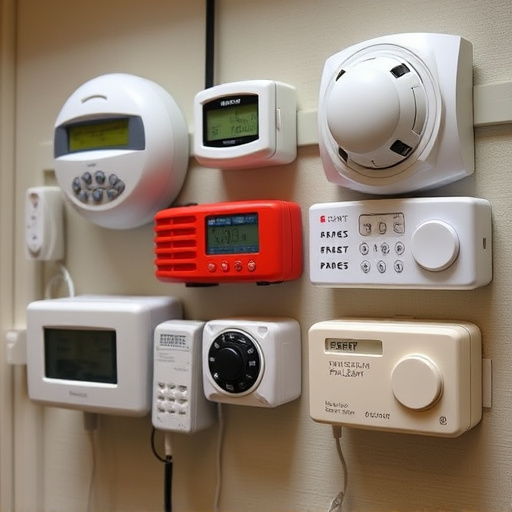Personal alarms with remote activation serve as cutting-edge, discreet wearable security solutions, ideal for outdoor enthusiasts, lone workers, and anyone needing immediate personal safety. These portable devices emit loud sounds, flash lights, and send alerts to pre-designated contacts upon remote activation, deterring threats in various settings. Advanced features like GPS tracking, automatic fall detection, and customizable alerts further enhance their effectiveness, providing peace of mind and empowering users to take control in vulnerable situations.
“Discover the revolution in personal safety with discrete wearable security alarm systems, a game-changer in self-protection. This article explores the multifaceted world of these innovative devices, focusing on their key features and benefits, particularly the power of remote activation. We’ll delve into the technology behind them, how they work, and their diverse practical applications. Whether for personal protection or specific use cases, wearable alarms offer a discreet yet powerful solution.”
- Understanding Discrete Wearable Security Alarm Systems
- Key Features and Benefits of Personal Alarms With Remote Activation
- How These Systems Work: Technology and Components
- Practical Applications and Use Cases for Wearable Security Alarms
Understanding Discrete Wearable Security Alarm Systems
Discrete wearable security alarm systems, such as personal alarms with remote activation, represent a cutting-edge solution for individual safety and security. Unlike traditional bulky alarm systems, these innovative devices offer a discreet yet powerful way to protect oneself in various environments. Wearable alarms are designed to be easily portable and accessible, allowing users to activate them swiftly when facing threats or emergencies. With a simple press of a button or remote control, the device can emit loud sounds, flash lights, or even send alerts to pre-designated contacts for immediate assistance.
This technology is particularly valuable in scenarios where individuals operate in remote areas, travel frequently, or have specific security needs. For instance, outdoor enthusiasts, lone workers, or personal safety advocates can benefit from the discreteness and convenience of these alarms. They provide a sense of empowerment by enabling users to respond swiftly to potentially dangerous situations, ensuring their well-being while maintaining a low profile.
Key Features and Benefits of Personal Alarms With Remote Activation
Personal alarms with remote activation offer a discrete yet powerful security solution for individuals seeking protection in various settings, from personal safety to property safeguard. A key feature is the ability to trigger an alarm from a distance, allowing users to quickly alert others or emergency services if they find themselves in distress. This remote functionality is particularly beneficial in crowded places where direct access to a device might be hindered. With just a simple button press or a voice command, a personal alarm can emit a loud, attention-grabbing sound, deterring potential threats and ensuring the user’s safety.
Moreover, these alarms often include advanced features such as GPS tracking, automatic fall detection, and customizable alert settings. The remote activation capability is just one aspect that enhances their effectiveness, providing users with peace of mind and a sense of security. This technology empowers individuals to take control of their safety, especially in situations where they may be vulnerable or isolated.
How These Systems Work: Technology and Components
Discrete wearable security alarm systems, often in the form of personal alarms with remote activation, leverage a blend of cutting-edge technology and strategic components to ensure maximum safety. These compact yet powerful devices typically incorporate sensors that detect unusual activities or movements, such as sudden changes in orientation or proximity. When triggered, the system activates an alarm, often through a loud siren and flashing lights, to deter potential threats immediately.
The core of these systems includes a microcontroller unit (MCU) that processes sensor data and makes critical decisions based on pre-programmed rules. Wireless communication modules enable remote activation via smartphone apps or dedicated control panels. A long-lasting battery powers the entire system, ensuring reliability in various environments. Additionally, some models offer GPS tracking for precise location identification, enhancing the effectiveness of emergency response services when activated.
Practical Applications and Use Cases for Wearable Security Alarms
Wearable security alarm systems, like personal alarms with remote activation capabilities, offer a range of practical applications and use cases that enhance personal safety in various settings. These devices are particularly useful for individuals who frequently travel alone, such as commuters, hikers, or late-night shift workers. With just a simple press of a button, wearers can trigger an alarm that not only alerts nearby bystanders but also connects to emergency services via a dedicated app or base station. This remote activation feature ensures swift response times, providing peace of mind and potentially saving lives in critical situations.
Moreover, wearable alarms can be invaluable for people attending social events, concerts, or festivals where crowded spaces and unfamiliar environments might pose security risks. The ability to discretely activate a personal alarm can deter potential threats and attract attention from nearby organizers or authorities. This technology empowers individuals to take charge of their safety, making it an attractive solution for those seeking enhanced security in everyday life.
Discrete wearable security alarm systems, particularly those with remote activation capabilities, offer unprecedented personal safety. By integrating advanced technology into everyday wearables, these systems provide peace of mind and enhanced security in various scenarios. The key features and practical applications highlighted here demonstrate their potential to revolutionize personal safety measures, making them a valuable investment for individuals seeking proactive protection.
